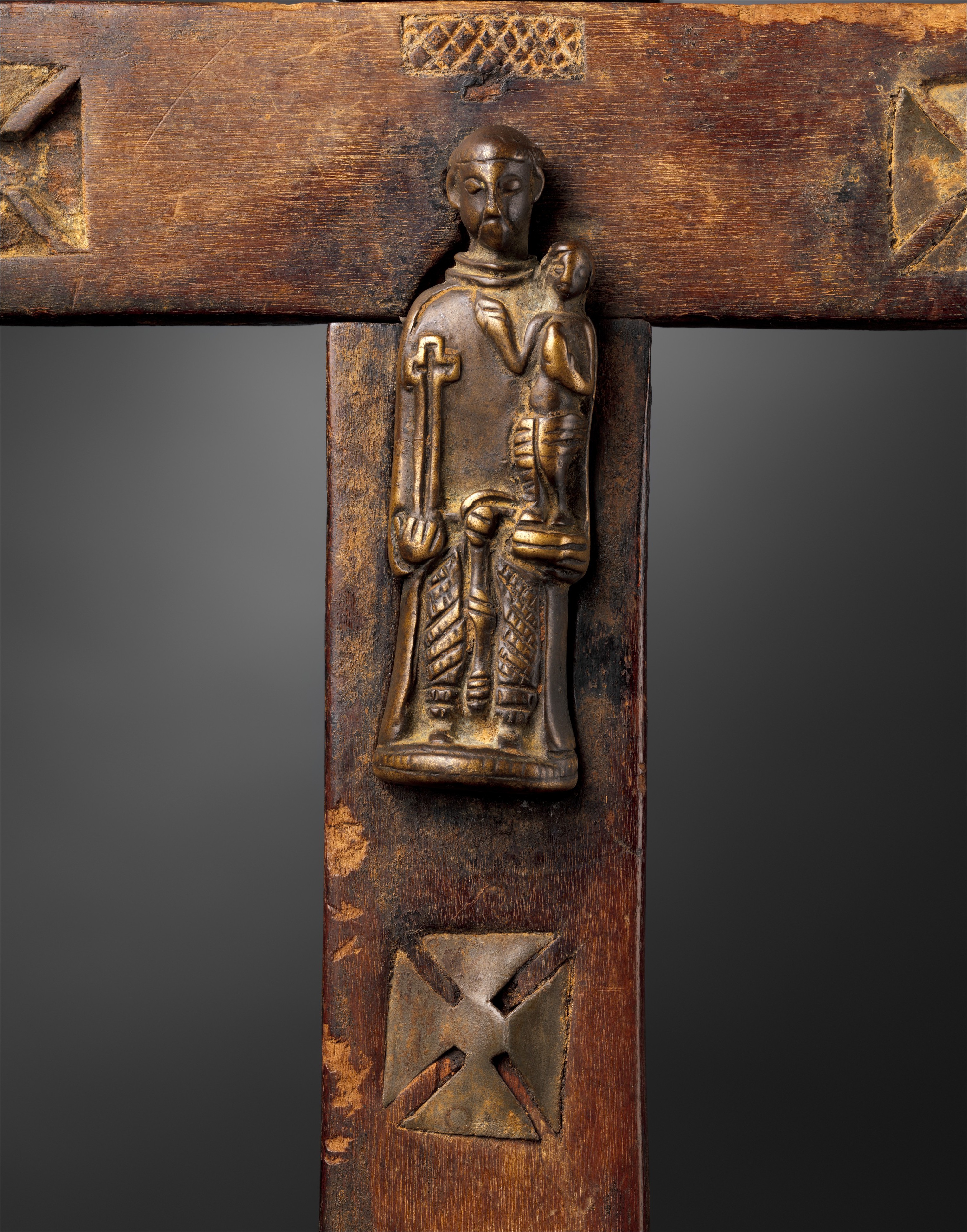Cross with Saint Anthony of Padua
This cross has been assembled from distinct components. The cross itself is composed of two pieces of wood with the horizontal element fitted into a notch in the vertical one so that both sections lie flush. In addition, niches have been carved into the surface of the wood for the inclusion of metalwork embellishments. The cross culminates in a rounded knob and a small band of cross–hatch patterning is carved at the center of the horizontal beam. The figure of a standing male, positioned in the niche at center, was originally a pendant that features a metal loop incorporated on the figure’s back. The loop has been employed to attach the figure to the wooden frame (see 1999.295.1 for a detached pendant). The figure wears the tonsure and triple-knotted belt of the Franciscan order and in his proper right hand he holds a cross. At his proper left side he supports a standing figure of Christ balanced on an open book and holding a bird. These distinctive attributes are based on a European prototype for depictions of Saint Anthony of Padua, a patron saint of Italy and Portugal. From the late fifteenth century, when the Kongo leadership adopted Christianity, they employed such devotional objects to demonstrate their political and religious authority. Saint Anthony became popular in Kongo after Italian Capuchin missionaries spread his cult in the mid-seventeenth century.
While Kongo artists drew inspiration from European prototypes in the creation of Christian devotional works, these symbols soon became central to Kongo religious practices. Missionary sources describe how Saint Anthony was claimed as the emblem of a Kongo religious reform movement led by the young noblewoman Beatriz Kimpa Vita (1684–1706). She encouraged the production of small statues of Saint Anthony among her followers, perhaps encouraging the widespread production of his image in Kongo. The visual impact of this work is enhanced by the addition of cruciform inlays in the shape of Maltese crosses positioned beneath the central figure and on the cross bar. The inlay remains extant at base and proper left with only the top section intact at proper right. The empty circular niche at top would likely also have contained a metalwork inlay, the dimensions suggest a medallion. Unlike the solid cast brass figure the inlay has been cut from sheet and is composed of a lead-tin alloy. The silver color of this metal might have been intended by the artist as a striking contrast to the brass of the figure and the dark wood of the cross.
This cross demonstrates remarkable continuities in Kongo visual expression over a four-hundred-year period. While the brass pendant figure and the cruciform inlays date from the sixteenth to eighteenth century, the wooden structure dates only to the nineteenth century, when it is likely this work was assembled.
[Cruciform inlay: Sn (%) 52.44; Pb (%) 47.17; Cu (%) 0.39. St. Anthony Figure: Cu (%) 80.17; Zn (%) 16.5; Pb (%) 2.61; Sn (%) 0.59; Fe (%) 0.38 SEM-EDS analysis conducted by Mark Wypyski, Research Scientist, Department of Scientific Research, Metropolitan Museum of Art (2000).]
James Green, 2015
Exhibition History
"Kongo: Power and Majesty." The Metropolitan Museum of Art, New York, NY: Sept. 16, 2015–Jan. 3, 2016
"African, Oceanic, and Ancient American Art: Recent Acquisitions."
Michael C. Rockefeller Special Exhibition Gallery, The Metropolitan Museum of Art, New York, NY: May 22–Oct. 28, 2001
Published References
LaGamma, Alisa. Kongo: Power and Majesty. New York: The Metropolitan Museum of Art, 2015. Exhibition Catalogue.
Thornton, John K. "Origin Traditions and History in Central Africa." African Arts 37 no.1 (2004), pp. 32-37.
LaGamma, Alisa. "New Acquisitions: The Metropolitan Museum of Art, New York." African Arts 34 no. 2 (2001), pp. 72-77.
Further Reading
Fromont, Cécile. The Art of Conversion: Christian Visual Culture in the Kingdom of Kongo. Chapel Hill: University of North Carolina Press, 2014.
Thornton, John K. The Kongolese Saint Anthony: Dona Beatriz Kimpa Vita and the Antonian Movement, 1684 – 1706. Cambridge: Cambridge University Press, 1998.
Due to rights restrictions, this image cannot be enlarged, viewed at full screen, or downloaded.
This artwork is meant to be viewed from right to left. Scroll left to view more.



